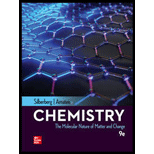
a)
Interpretation: To determine whether
Concept introduction: Depending on the ability of the ion to react with water the nature of the salt can be determined. If the cation is a strong base and the anion is a strong acid, then the solution or the salt will be neutral. If the cation is a weak base and the anion is a strong acid, then the solution will be acidic. If the cation is a strong base and the anion is a weak acid, then the solution will be basic.
b)
Interpretation: To determine whether
Concept introduction: Depending on the ability of the ion to react with water the nature of the salt can be determined. If the cation is a strong base and the anion is a strong acid, then the solution or the salt will be neutral. If the cation is a weak base and the anion is a strong acid, then the solution will be acidic. If the cation is a strong base and the anion is a weak acid, then the solution will be basic.
c)
Interpretation: To determine whether
Concept introduction Depending on the ability of the ion to react with water the nature of the salt can be determined. If the cation is a strong base and the anion is a strong acid, then the solution or the salt will be neutral. If the cation is a weak base and the anion is a strong acid, then the solution will be acidic. If the cation is a strong base and the anion is a weak acid, then the solution will be basic.
Want to see the full answer?
Check out a sample textbook solution
Chapter 18 Solutions
Chemistry: The Molecular Nature of Matter and Change
- Write the chemical equation and the expression for the equilibrium constant, and calculate Kb for the reaction of each of the following ions as a base. (a) sulfate ion (b) citrate ionarrow_forwardThe hydrogen phthalate ion, C8HsO4, is a weak acid with Ka = 3.91 106. C8H5O4(aq)+H2O(l)C8H4O42(aq)+H3O+(aq) What is the pH of a 0.050 M solution of potassium hydrogen phthalate. KC8H5O4? Note: To find the pH for a solution of the anion, we must take into account that the ion is amphiprotic. It can be shown that, for most cases of amphiprotic ions, the H3O+ concentration is [H3O+]=Ka1Ka2 For phthalic acid, C8H6O4 is Ka1 is 1.12 103, and Ka2 is 3.91 106.arrow_forwardGiven that methylamine, CH3NH2, has a Kb of 4.4 x 10-4, what is the pH of a 0.20 M aqueous solution of methylamine?arrow_forward
- What is the conjugate acid of potassium hydrogen phosphate, K2HPO4?arrow_forwardSolubility of gases in water increases with increasing mass. Explain? What is the relationship between the value of pKa and the strength of a weak acid?arrow_forwardThe pH of an aqueous solution of pyridine (C5H5N) is 10.0 at room temperature. What is the initial molar concentration of C5H5N, if its base ionization constant is: Kb = 1.7×10–9?arrow_forward
- The ionization constant, Ka, for dichloroacetic acid, HC2HO2Cl2 , is 5.0 × 10‑2. What is the pH of a 0.15 molar solution of this acid?arrow_forwardAt 250°C, the equilibrium constant for the dissociation of water is 10–11.16. At this temperature, what is the pH of a neutral solution?arrow_forwardWhat is the conjugate base of [Fe (H2O)6]^3+ (aq) ?arrow_forward
 Chemistry: Principles and PracticeChemistryISBN:9780534420123Author:Daniel L. Reger, Scott R. Goode, David W. Ball, Edward MercerPublisher:Cengage Learning
Chemistry: Principles and PracticeChemistryISBN:9780534420123Author:Daniel L. Reger, Scott R. Goode, David W. Ball, Edward MercerPublisher:Cengage Learning Chemistry & Chemical ReactivityChemistryISBN:9781133949640Author:John C. Kotz, Paul M. Treichel, John Townsend, David TreichelPublisher:Cengage Learning
Chemistry & Chemical ReactivityChemistryISBN:9781133949640Author:John C. Kotz, Paul M. Treichel, John Townsend, David TreichelPublisher:Cengage Learning Chemistry & Chemical ReactivityChemistryISBN:9781337399074Author:John C. Kotz, Paul M. Treichel, John Townsend, David TreichelPublisher:Cengage Learning
Chemistry & Chemical ReactivityChemistryISBN:9781337399074Author:John C. Kotz, Paul M. Treichel, John Townsend, David TreichelPublisher:Cengage Learning Chemistry: Principles and ReactionsChemistryISBN:9781305079373Author:William L. Masterton, Cecile N. HurleyPublisher:Cengage Learning
Chemistry: Principles and ReactionsChemistryISBN:9781305079373Author:William L. Masterton, Cecile N. HurleyPublisher:Cengage Learning Chemistry: The Molecular ScienceChemistryISBN:9781285199047Author:John W. Moore, Conrad L. StanitskiPublisher:Cengage Learning
Chemistry: The Molecular ScienceChemistryISBN:9781285199047Author:John W. Moore, Conrad L. StanitskiPublisher:Cengage Learning




